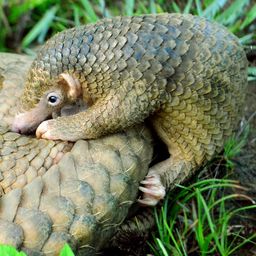
Red pandas
From Wikipedia
The red panda (Ailurus fulgens), also known as the lesser panda, is a small mammal native to the eastern Himalayas and southwestern China. It has dense reddish-brown fur with a black belly and legs, white-lined ears, a mostly white muzzle and a ringed tail. Its head-to-body length is 51–63.5 cm (20.1–25.0 in) with a 28–48.5 cm (11.0–19.1 in) tail, and it weighs between 3.2 and 15 kg (7.1 and 33.1 lb). It is well adapted to climbing due to its flexible joints and curved semi-retractile claws.

Etymology
The origin of the name panda is uncertain, but one of the most likely theories is that it derived from the Nepali word “ponya”. The word पञ्जा pajā or पौँजा pañjā means “ball of the foot” and “claws”. The Nepali words “nigalya ponya” has been translated as “bamboo footed” and is thought to be the red panda’s Nepali name; in English, it was simply called panda, and was the only animal known under this name for more than 40 years; it became known as the red panda or lesser panda to distinguish it from the giant panda, which was formally described and named in 1869.
Description
The red panda’s coat is mainly red or orange-brown with a black belly and legs. The muzzle, cheeks, brows and inner ear margins are mostly white while the bushy tail has red and buff ring patterns and a dark brown tip. The colouration appears to serve as camouflage in habitat with red moss and white lichen-covered trees. The guard hairs are longer and rougher while the dense undercoat is fluffier with shorter hairs. The guard hairs on the back have a circular cross-section and are 47–56 mm (1.9–2.2 in) long. It has moderately long whiskers around the mouth, lower jaw and chin. The hair on the soles of the paws allows the animal to walk in snow.
Related


